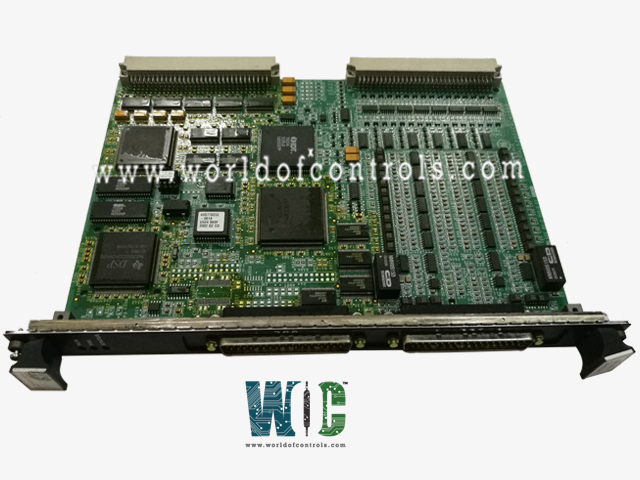SPECIFICATIONS
Part No.: IS200VCRCH1BBB
Manufacturer: General Electric
Country of Manufacture: United States of America (USA)
Size: 26.04 cm high x 1.99 cm wide x 18.73 cm deep
Temperature: 0 to 60 oC
Max response time on: 25 ms
Max response time off: 25 ms
Relay contact material: Silver cad-oxide
Number of channels: 48
Product Type: Discrete Input/Output Board
Availability: In Stock
Series: Mark VI
Functional Description
IS200VCRCH1BBB is a discrete input/output board developed by GE. It is a part of Mark VI control system. The Contact Input/Relay Output Board is a module designed for managing numerous discrete input and output signals within a VME-based system. This narrow module is integral to control systems that require robust input/output handling capabilities.
Features
- Inputs and Outputs: Along with its associated daughterboard, is capable of handling a substantial number of signals. It accepts up to 48 discrete inputs, which allows it to monitor a wide range of external signals and statuses. In addition to input capabilities, controls 24 relay outputs. These outputs enable the board to activate or deactivate external devices, such as motors, lights, or other relay-driven equipment.
- Terminal Boards: The input and output signals are managed through a total of four terminal boards. These terminal boards serve as the interface points where the external wiring connects to the module. The specific terminal boards associated are:
- TBCI : This board is used to connect the discrete input signals.
- TRLY: This board is used to connect and control the relay outputs.
- VME I/O Rack Mounting: The module is designed to mount within a VME I/O rack, which is a standardized hardware platform commonly used for industrial and embedded computing applications. The VME rack provides the necessary infrastructure for power, cooling, and interconnectivity between various modules.
- Connectivity: The VME I/O rack includes two sets of J3/J4 plugs. These plugs are used for the connection of cables to the TBCI and TRLY terminal boards. The J3/J4 connectors are part of the VMEbus standard, providing a reliable means of communication and power distribution between the module and its associated terminal boards.
Contact Inputs
- First 24 Inputs: The initial set of 24 dry contact inputs is wired to a dedicated contact input terminal board known as the TBCI (Terminal Board for Contact Inputs). This board serves as the primary interface for connecting these input signals to the system.
- Inputs 25-48: For handling inputs from 25 to 48, a second TBCI terminal board is required. This configuration allows the system to expand its input capacity seamlessly by adding another terminal board, maintaining the same level of organization and accessibility.
- DC Power Provision: The system provides direct current (DC) power for the contact inputs, ensuring that the necessary power for signal detection and processing is readily available. This internal power provision simplifies the wiring and reduces the need for external power sources.
- Cables with Molded Plugs: Connection between the terminal boards and the VME rack is facilitated through cables with molded plugs. These cables are designed for secure and reliable connections, minimizing signal loss and interference. They connect directly to the processor board located in the VME rack, ensuring efficient data transmission.
- 1 ms Scanning Rate: The system supports high-speed scanning and recording of contact inputs at a rate of 1 millisecond (ms). This capability is crucial for applications that require precise and rapid monitoring, such as turbine control systems, where real-time data acquisition is essential.
- Sequence of Events (SOE) Recorder: The SOE recorder is a key feature that captures all contact openings and closures with a time resolution of 1 ms. This high-resolution recording allows for detailed event tracking and analysis, critical for diagnosing issues and ensuring system reliability.
- Contact Chatter Reporting: The system is designed to detect and report contact chatter, which refers to the rapid, repetitive opening and closing of a contact. This feature helps in identifying and troubleshooting transient faults or unstable conditions in the monitored equipment.
- Pulse Width Detection: It can also report pulse widths down to 6 ms, providing detailed information on very short-duration events. This level of detail is important for accurately capturing transient events that might otherwise be missed.
The WOC team is always available to help you with your Mark VI requirements. For more information, please contact WOC.
Frequently Asked Questions
What is IS200VCRCH1BBB?
It is a Discrete Input/Output Board developed by GE under the Mark VI series.
How are the first 24 contact inputs connected?
The first 24 dry contact inputs are connected to a contact input terminal board known as TBCI (Terminal Board for Contact Inputs).
What if I need more than 24 inputs?
For inputs 25 to 48, a second terminal board is required. This setup allows the system to expand its input capacity by simply adding another terminal board.
Is external power needed for the contact inputs?
No, DC power for the contact inputs is provided internally by the system. This simplifies wiring and eliminates the need for external power sources.
How are the terminal boards connected to the VME rack?
The terminal boards are connected to the VME rack via cables with molded plugs. These cables ensure secure and reliable connections, facilitating efficient data transmission to the processor board in the VME rack.
What is the scanning rate for the contact inputs?
The system supports high-speed scanning and recording at a rate of 1 millisecond (ms). This is crucial for applications requiring precise and rapid monitoring.
